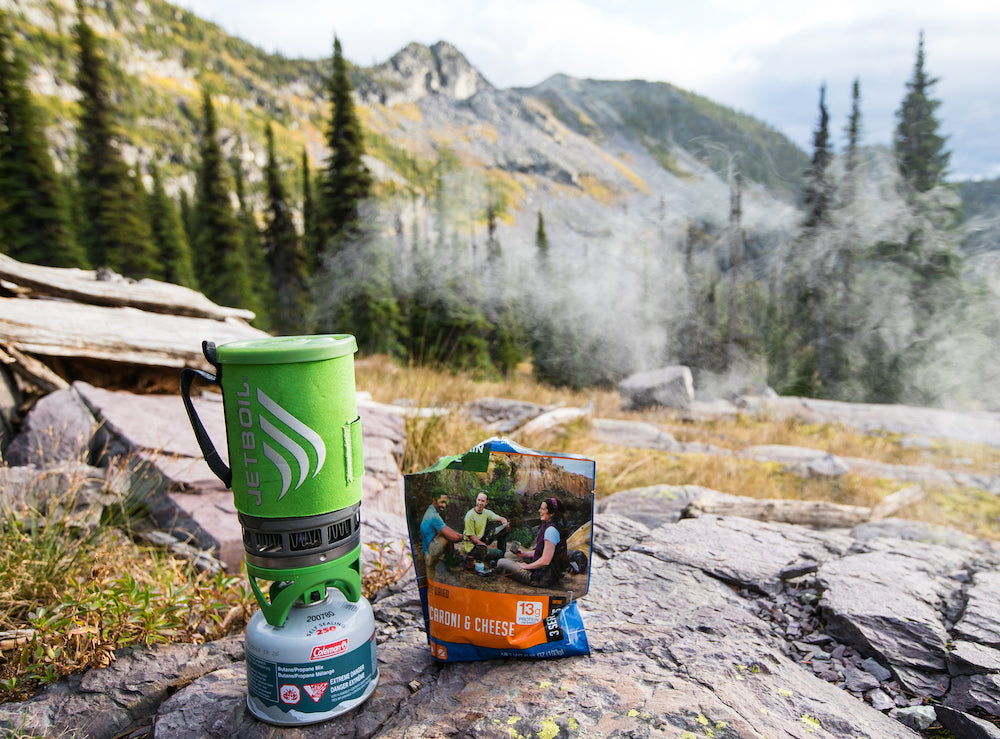How Does Altitude Affect The Boiling Point Of Water
The siren vocal of the mountains calls loud and clear to nearly backpackers, which ways nosotros're often camping ground well above bounding main level. Too impacting our ain physiology, distance has an influence on how long information technology takes to eddy water—and, therefore, how long it takes to fix uncooked food. For many of you, the following will be a no-brainer rehash, but a goodly number of people still become (understandably) dislocated about the relationship between boiling indicate, cooking time, and altitude, so we thought we'd run through a quick and basic primer on the subject. Whether you're going ski-touring in the well-nigh time to come or you're spending this winter scheming upwards awesome high traverses for the summer, read on for a trivial boiling-h2o-at-altitude 101!
The Nuts of Boiling Water at High Altitudes
At increasing altitude, atmospheric pressure level declines. Very roughly speaking, you can remember of information technology like this: There's more air to a higher place a point at body of water level, which means the atmospheric pressure is greater hither than at higher altitudes where there's less air bearing down above. This fundamental physical rule explains a lot of important weather phenomena likewise every bit that annoying ear-popping thing when you're flying in an airplane or driving upwards or downward a mountainside.
It also impacts the humid point of h2o: the temperature at which liquid water begins turning to vapor, which occurs when its vapor pressure equals the atmospheric pressure. At a higher elevation, the lower atmospheric pressure means heated water reaches its boiling point more apace—i.due east., at a lower temperature. Water at sea level boils at 212 degrees Fahrenheit; at 5,000 feet in a higher place body of water level, the humid indicate is 203 degrees F. Up at x,000 feet, water boils at 194 degrees F.
This is the opposite of what many people suppose: that water takes longer to boil on high. As nosotros've just demonstrated, humid h2o at distance is quicker. But the fact that the boiling temperature is lower at higher elevations ways nutrient takes longer to cook, which is where the confusion lies. At 5,000 feet, where water boils virtually ten degrees cooler than at bounding main level, y'all need to roughly double the cooking time.
In terms of a crude boiling signal pinnacle equation, subtract about 1 caste from the boiling temperature with each 500-foot increase in elevation.
The Wind Cistron & Other Caveats
Now, go along in mind that loftier-elevation cooking sites often contend with air current, and that, of course, can affect how long h2o comes to a boil past whipping that gas flame around and otherwise making it harder to rut upward your pot. Choosing a sheltered spot and shielding your stove and cook vessel from the gusts with a windscreen will help ward against this factor, which may also explain why some outdoorspeople think it takes longer to heat h2o to a boil upward in the mountains.
Then there's the fact that dissimilar stove fuels perform ameliorate or worse at high elevations and in the colder temperatures typically encountered up there. All things considered, liquid-fuel stoves are the best bet for loftier-elevation camping. At high altitude or subfreezing weather, canister stoves won't work besides, and at all-time it may take longer to bring your h2o to a boil, if it gets in that location at all. (Learn more than in our "Choosing a Backpacking Stove" blogpost.)
The Advantages of Mountain Firm in the High Land
That longer cooking fourth dimension at higher elevations has an important affect on backpacking. To cook the same meal up in the mountains or plateaus, you lot'll need to invest more fuel and more time. On extended trips in the high country, foods that require lengthy and/or multi-footstep cooking aren't skilful choices, considering they'll translate to hauling that much more than fuel in your pack.
Instant-type meals that only require heating are the improve choice, and that includes our only-add-hot-water Mountain House delicacies. In fact, you don't fifty-fifty need hot water to prepare Mount House: You lot tin can use cold h2o to rehydrate our freeze-stale meals—just give the food virtually double the cooking time listed on the package.

Humid Point, Altitude, and Water Purification
At present, what near using boiling to purify water—how is that impacted by distance? Boiling is the surefire way to kill pathogens and make water safe to potable. Do y'all need to worry well-nigh the lower humid temperature of water in the loftier country?
Basically, you don't. The Centers for Disease Command & Prevention recommends letting water stand up at a rolling boil for a minute at bounding main level to purify it, and extending that to 3 minutes of rolling boil above about 6,500 feet. Many experts, even so, fence that simply allowing water to reach a rolling boil renders it safe, regardless of your elevation—see this World Health Organization document, for case, also equally these posts from Off the Grid and Backpacker. Even the lower boiling-point temperatures at high mountains on Earth is sufficient to impale pathogens. If y'all desire to cover all your bases, by all ways, follow the CDC guidelines, just if yous're existence fuel-conscious you're likely going to be fine simply bringing water to a rolling boil.
For more than information, bank check out our Mount House weblog post on "How to Purify H2o" and definitely our "Tips for Cooking at Loftier Altitude."
How Does Altitude Affect The Boiling Point Of Water,
Source: https://mountainhouse.com/blogs/backpacking-hiking/effects-of-altitude-on-water-boiling-time#:~:text=At%20a%20higher%20elevation%2C%20the,point%20is%20203%20degrees%20F.
Posted by: davisstectint.blogspot.com



0 Response to "How Does Altitude Affect The Boiling Point Of Water"
Post a Comment